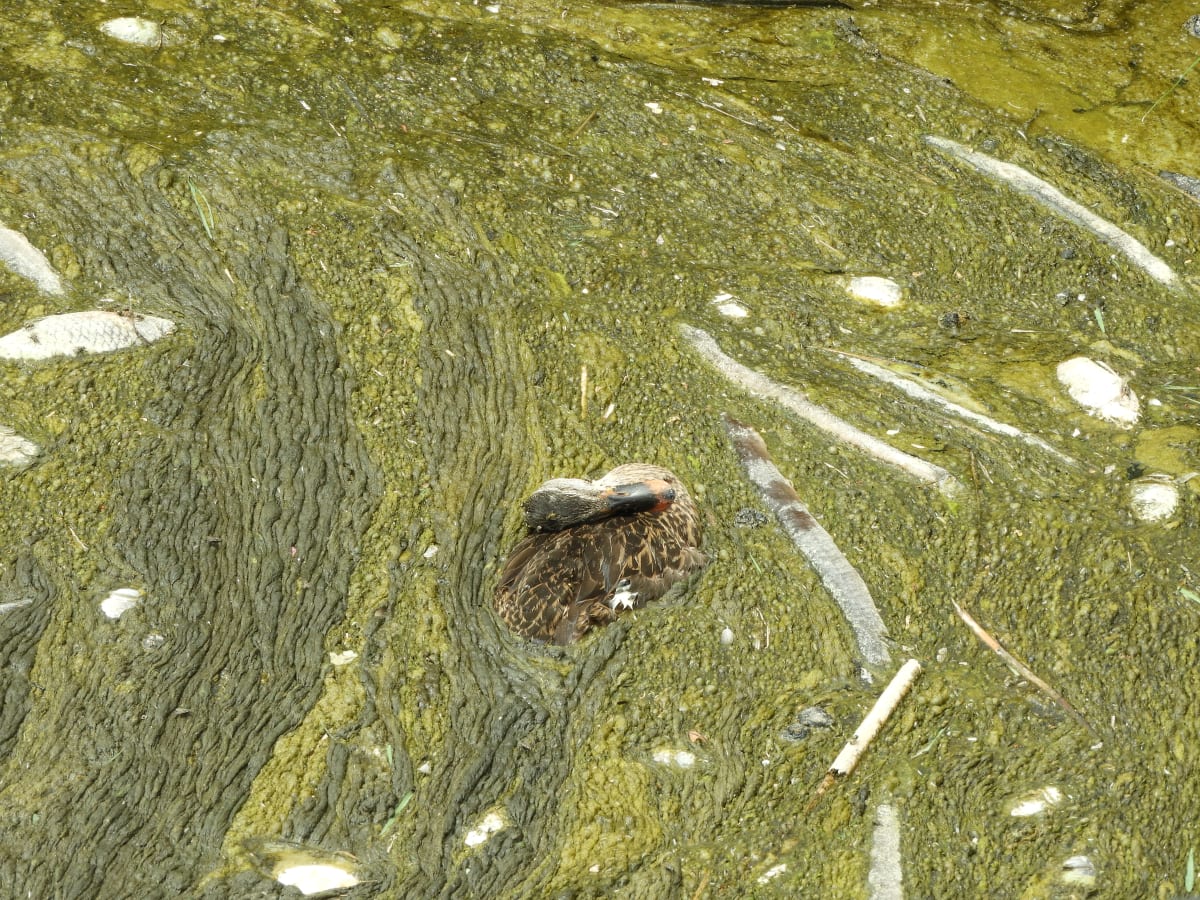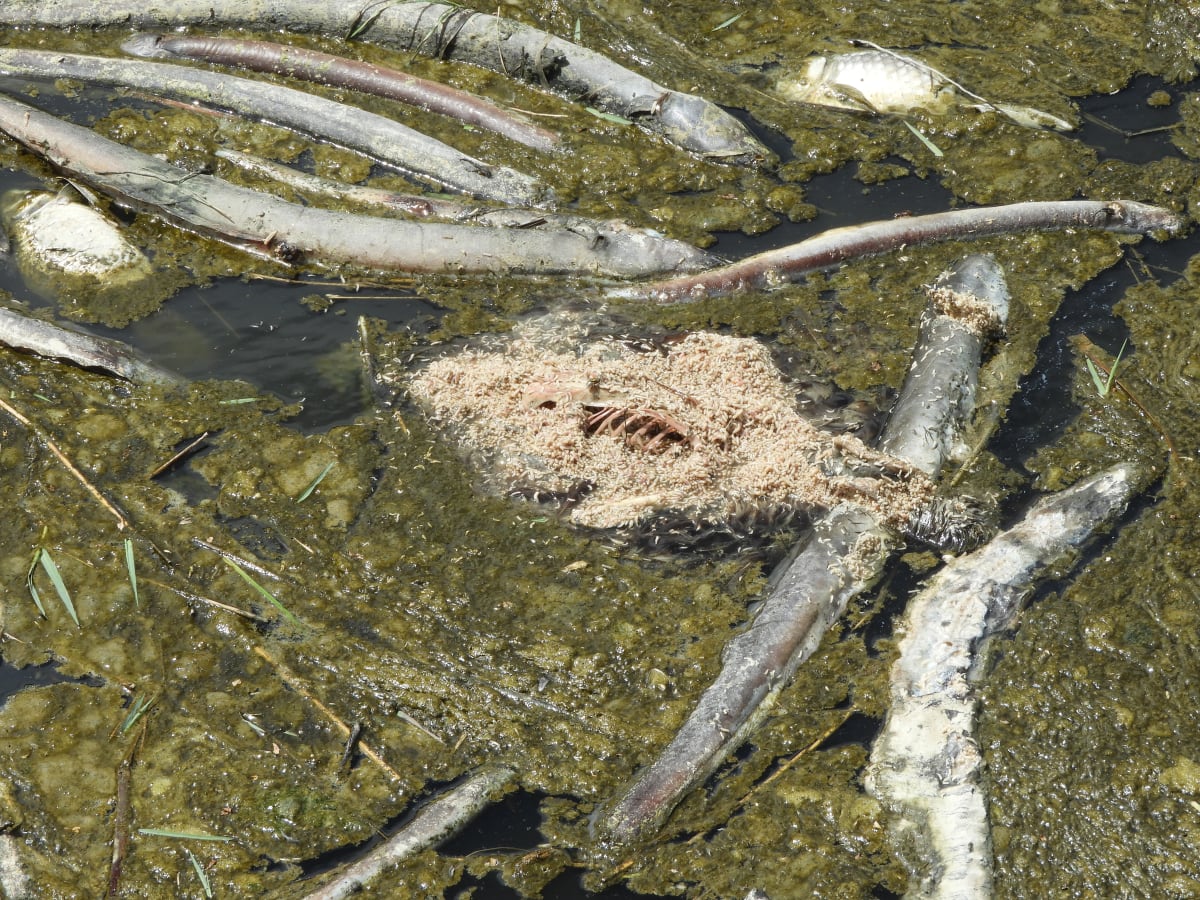A lethal combination of heat, silted-up floodgates and degraded waterways has led to a deadly outbreak of botulism and a suspected toxic algal bloom
Parts of the Hauraki Plains have become killing fields for ducks and eels as summer heat exacerbates existing habitat problems.
There’s been a triple whammy of death. Algal blooms have turned water into a “pea soup” and a hot summer has seen unshaded drains reach 29°C. Eels trying to escape the adverse conditions have been trapped behind silted-up floodgates and died. Botulism has broken out killing thousands of ducks. Added to this is a suspected toxic algal bloom that has killed and sickened shorebirds.
The outbreaks are putting two internationally significant Ramsar wetlands – Kopuatai Peat Wetland and the Firth of Thames mudflats – at risk. Most of the bird deaths have been ducks, but protected species including shags, spoonbills, herons, harriers, stilts, banded dotterels, and Caspian terns are also affected.
Staff from Fish & Game, the Department of Conservation, SPCA, as well as volunteers including local farmers, iwi and bird rescue groups, have been assisting in the clean-up. Around 3500 dead ducks have been removed as well as an unknown number of fish. Six teams of hunter volunteers are working around the Firth of Thames on an almost daily basis to remove dead birds and minimise the impact of the outbreak.

For those on clean-up duty it’s been a heartbreaking and gruesome task.
When a duck gets botulism it’s a case of slow paralysis that starts in their legs. Birds on water can be seen using their wings as oars to push themselves along. When the paralysis reaches their wings it’s a case of floating. When it reaches their neck it’s all over. Their head drops into the water and they drown.
“To be honest it’s probably a better way to go,” said Fish & Game’s Auckland-Waikato gamebird manager David Klee.
“The birds on land, they’ll die through dehydration. That’s obviously a longer, protracted death. There’s nothing nice about how these birds are dying down there. It’s pretty nasty.”
The maggots that feed on the corpses spread the disease. One botulism-affected maggot is a tasty-looking but deadly treat for a hungry duck. Removing carcasses and maggots is a key way to stop outbreaks from spreading.

Floodgates trap eels
There’s been a culmination of events that’s potentially led to the botulism outbreak.
“You’ve got high temperatures, high nutrients, it creates these big algal outbreaks,” said Klee.
When this occurs the oxygen levels in the water can plummet overnight. Ironically, the lack of available oxygen can drown fish.
“It’s a combination of hot temperatures, low oxygen and in some cases reduced water levels, so the water is disappearing around them. It’s either a stranding mortality or just the environment in those drains is just not sufficient to sustain life anymore.”
Klee said some of the area was below sea level. Floodgates allow water out of the drains and also stop salt water washing into them. In summer, when there’s no excess water flow washing out of the system for months on end, floodgates can get blocked with sediment. Opening them requires a digger.
“Traditionally no one does that in summer because there is no flow. Why would you bother opening up a gate when you don’t need to drain any water out of the system?”
The eels caught in drains were unable to escape because of the floodgates.
In the drain Klee helped clean, he estimates there were hundreds “if not thousands” of dead eels. He was unable to tell if the dead eels were shortfin eels or at-risk longfin eels.
“A lot of them had been there for that length of time. When you pick them up, they start falling apart.”
Klee said while no one had been able to pinpoint exactly what sets off a botulism outbreak, they are usually correlated with hot temperatures and low oxygen levels, which lead to fish deaths.
The botulism bacteria needs a protein-based substance to flourish and dead fish are ideal for this. It’s possible the dead eels helped the bacteria trip over from being inert in the sediment to causing deaths.
Fixing the problem
A key point Klee wants to get across is there are multiple stresses on the environment. Warm temperatures alone wouldn’t be likely to kill on their own if the drains weren’t already degraded.
“The fact some of our most pollution-tolerant species such as eels are now dying en masse gives an indication just how bad the situation is there now.”
Klee said a regional council report found the area to be one of the worst in regard to nutrient loads. This is from agricultural run-off as well as ‘point-source’ discharges. These are fixed points where pollution enters water and can be related to industry or infrastructure.
With longer, hotter summers predicted in the future, it’s likely the situation will become more common.
“It would be unfair to blame these events on temperature alone, however, triggers for botulism and the algal bloom outbreak include excessive nutrient loads in streams and canals feeding into the Firth. Human activity has adversely impacted this catchment to the point where its resilience is severely compromised.”
He said there were practical steps that could be taken to improve the situation. Trees to provide shade could be planted to reduce water temperature.
“Water level maintenance, shading, flushing. Those are practical steps which can be taken.”
He also thinks a catchment group should be set up so problems can be addressed early. In this situation there were warning signs things could go “pear-shaped” in December.
“We are going to have to start treating these areas differently if we are going to expect a different outcome.”
The Department of Conservation’s senior ranger biodiversity for the Hauraki, Mailee Stanbury, said there wasn’t a quick fix.
“… we need all the associated agencies, land users and industries creating and managing discharges to come on board.”



